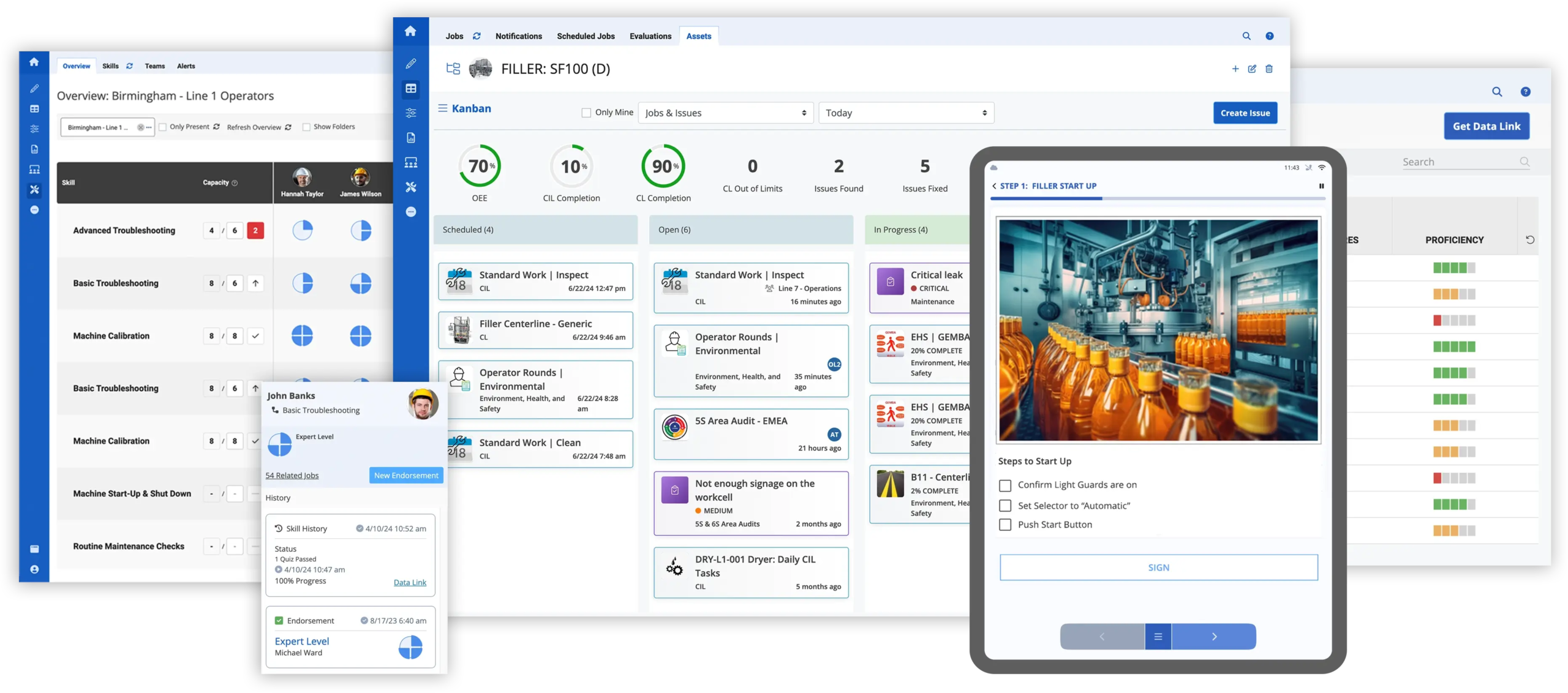What is Mura?
Lean management, founded by Toyota Motor Corporation, is a proven methodology that focuses on maximizing value by eliminating inefficiencies. In Lean management, Mura is one of the Three Ms—Muda (Waste), Mura (Unevenness), and Muri (Overburden)—which represent key obstacles to efficient, value-driven operations.
Mura refers to inconsistency, irregularity, or unevenness in a process, workload, or flow of materials. Unlike waste (Muda), which is easier to spot (like excess inventory or waiting time), Mura often appears as variations in timing, output, or task demand that lead to hidden inefficiencies. While Mura is often less visible than waste, it can have just as significant an impact by creating bottlenecks, overburdening resources, and disrupting workflow.
In this guide, we’ll explore what Mura is, how it differs from other Lean concepts, what causes it, and how it can be identified and eliminated—especially with the help of modern connected worker solutions like Augmentir.
Why Mura Matters
Unchecked Mura leads to:
- Bottlenecks and idle time
- Employee stress and errors
- Reduced throughput
- Inconsistent product or service quality
It often cascades into Muda (waste) and Muri (overburden), amplifying inefficiency.
Common Causes of Mura
- Volatile customer demand
- Batch production practices
- Lack of standardized processes
- Poor cross-functional coordination
- Manual, reactive scheduling
How to Identify Mura
Watch for:
- Workload imbalances
- Inventory swings
- Task-switching or frequent reprioritization
- Quality issues under pressure
Use tools like:
- Value Stream Mapping
- Production analytics
- Gemba Walks
How to Reduce or Eliminate Mura
Reducing Mura requires creating systems that promote flow, balance workloads, and reduce variability in how work is planned and executed. Unlike Muda (waste), Mura can be subtle—arising from misaligned schedules, inconsistent procedures, or unpredictable demand. Tackling Mura involves a mix of process discipline and real-time adaptability, both of which can be greatly enhanced with modern digital solutions.
1. Heijunka (Level Scheduling)
Heijunka is the Lean technique of leveling production by spreading work evenly over time. This helps avoid sudden spikes or lulls in activity that disrupt flow.
Benefits:
- Reduces overburden on workers or machines
- Improves predictability in operations
- Makes waste and inefficiencies more visible
Lean in Action: Instead of producing large batches of one item, use mixed-model production to match real customer demand in smaller, balanced increments.
2. Standardized Work
Standardized work ensures that each task is performed consistently, regardless of who performs it or when. This reduces variation in output and quality.
Benefits:
- Improves repeatability and efficiency
- Makes it easier to train new workers
- Enables continuous improvement by creating a stable baseline
Lean in Action: Document and digitize work instructions, and ensure they are followed consistently on the shop floor.
3. Cross-Training and Workforce Flexibility
Unbalanced workloads often stem from over-reliance on a few specialized workers. Cross-training builds flexibility into your workforce so tasks can be shifted smoothly based on demand.
Benefits:
- Minimizes downtime due to labor shortages or absences
- Balances work more evenly across teams
- Enables dynamic task reallocation
Lean in Action: Use a skills matrix to track employee capabilities and design rotational training programs.
4. Just-In-Time (JIT) Operations
JIT focuses on delivering the right materials, parts, or tasks at the exact time they’re needed—no earlier, no later.
Benefits:
- Reduces excess inventory and work-in-progress
- Eliminates gaps or surges in task availability
- Prevents waiting and overproduction
Lean in Action: Implement pull-based systems like Kanban to control workflow and reduce overproduction.
5. Visual Management Tools
Visual cues help teams quickly understand current status, priorities, and problems—making it easier to spot and respond to unevenness in real time.
Benefits:
- Enhances transparency and communication
- Prevents information silos
- Supports faster decision-making
Lean in Action: Use visual boards, color-coded task indicators, and digital dashboards to display progress and status.
6. Smart Digital Tools
Smart digital tools amplify traditional Lean methods by offering real-time visibility, AI-driven decision support, and adaptive workflows that reduce variability and respond instantly to changing conditions.
Examples of Smart Tools That Reduce Mura:
- Connected Worker Platforms (e.g., Augmentir): Deliver digital work instructions tailored to skill levels, dynamically assign tasks, and provide real-time support.
- AI-Powered Scheduling Engines: Automatically balance workloads based on current capacity, skillsets, and demand forecasts.
- Real-Time Dashboards and Alerts: Flag issues like bottlenecks, task delays, or idle time as they occur.
- Skills Intelligence Systems: Skills intelligence is used to identify the best-fit workers for each task to maintain consistent performance and reduce mismatch-based variation.
- Mobile and Wearable Tech: Ensure frontline workers stay connected, receive updates immediately, and can adapt quickly without introducing variability.
Lean in Action: Use data and AI to dynamically assign work, prevent overload, and improve response times when demand or conditions shift unexpectedly.
How Augmentir Impacts Mura
Augmentir is a connected worker platform that directly addresses Mura by eliminating inconsistency and variability in frontline operations through a combination of AI, digital workflows, and real-time performance insights.
1. Standardized Work Execution
- Delivers personalized digital work instructions that ensure every worker follows best practices
- Reduces variability in task performance
- Enables consistent output across teams and shifts—even in high-mix, low-volume environments
2. AI-Based Workforce Optimization
- Analyzes individual and team performance data
- Recommends optimal task assignments based on skill level, availability, and work history
- Balances workloads in real time to reduce stress and bottlenecks
3. Real-Time Visibility
- Provides live insights into job progress, bottlenecks, and idle time
- Enables proactive rebalancing of resources
- Reduces the risk of cascading delays due to uneven work
4. Connected Support
- Allows workers to request support or escalate issues instantly
- Helps maintain flow during unexpected disruptions
- Reduces downtime caused by variation or uncertainty
5. Continuous Improvement
- Identifies patterns of inconsistency through analytics
- Recommends improvements to digital workflows and training content
- Drives long-term performance leveling across the workforce
Conclusion
Mura may not always be visible, but it has a powerful impact on flow, quality, and efficiency. By combining Lean principles with modern connected worker solutions like Augmentir, organizations can detect and eliminate unevenness in real time—empowering their workforce, enhancing productivity, and building operational resilience.

